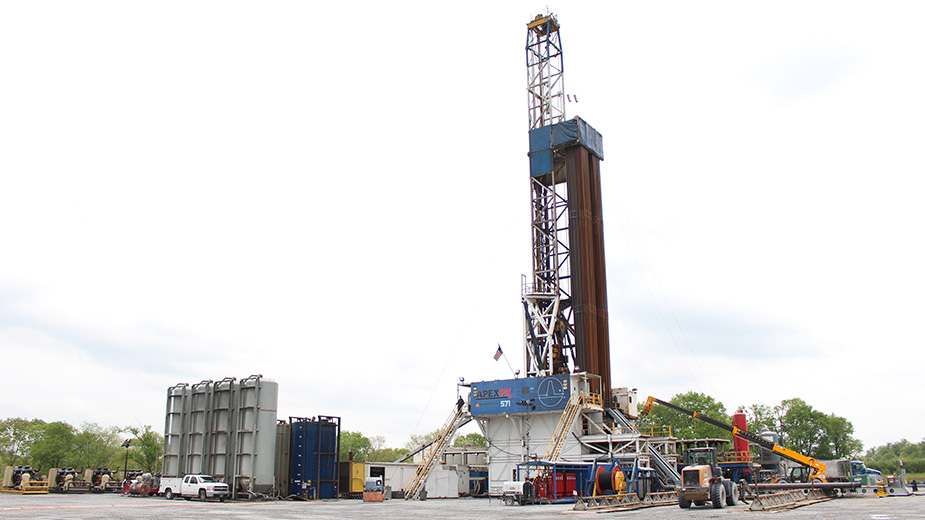It’s the Teachers Who Learn about Drilling Down
YOUNGSTOWN, Ohio – June Baker, a fifth-grade English teacher at Boardman Center Middle School, helps direct a table of five other teachers as they tackle the fundamentals of “sweet exploration” in the oil and gas industry.
“The best part of this is the collaborative learning,” she said. “We all work together to solve a problem.”
Baker and 38 other teachers from across the Mahoning Valley and beyond received an up-close tutorial Monday at Youngstown State University on how the oil and gas industry operates in Ohio as well as tips on integrating what they learned into their classrooms on the fundamentals of energy development.
The Ohio Oil and Gas Energy Education Program, or OGEEP, is sponsoring the two-day workshop that ends today.
Baker’s group was charged with using household items – in this case a flexible straw and a Hostess Twinkie – to demonstrate the difference between vertical well exploration and horizontal drilling.
The premise is to take items with which students can identify and use them to illustrate how the oil and gas business works. In the Twinkie project – dubbed “Sweet Exploration” — Baker and the others showed how much cream filling can be extracted when the straw is inserted vertically in the Twinkie. Then, they document how much more can be tapped when that straw is bent at a 90-degree angle.
“It doesn’t have to be scientifically accurate,” Baker says as she laughs.
The group experiments are part of a workshop program that OGEEP holds every year and is geared toward educating elementary, middle school and high school teachers about oil and gas exploration, said Mark Bruce, communications director for OGEEP.
“We’ve been doing these workshops since 1998,” he said. At the outset, OGEEP hosted one workshop in Marietta, but over the last several years the program has grown to include a workshop in the northeastern part of the state. Two years ago, OGEEP played host to a similar program in Canfield.
Over the past five years, Ohio has emerged as a major producer of natural gas, Bruce said, especially since energy companies have explored the Utica shale in earnest. Last year, for example, Ohioans consumed 913 billion cubic feet of natural gas and produced 458 billion cubic feet. Next year, it’s projected that the wells in the state will produce more than 800 billion cubic feet, he told the group.
“We’re almost an energy-independent state,” he said.
The OGEEP curriculum, Bruce continued, is based on the state standards for science education that involve disciplines such as geology and chemistry. “It’s based on what kids need to learn,” he said. “Some teachers will take it and plug it in to what they have. Some may pick and choose our experiments to fit in with what they teach at certain times and when they have to teach it.”
About half of the teachers who attended the Monday’s workshop are from Mahoning, Trumbull and Columbiana counties, while others traveled several hours to attend.
Zachary Dunn, a high school teacher in Lima, traveled three hours to be at the workshop yesterday. He and Jodi Haylett, a chemistry, biology and anatomy teacher at Beaver Local High School, performed an experiment that demonstrates how the refining process works.
Instead of oil, however, the group used mouthwash to show how oil is distilled and purified. “I’d like to incorporate this into one of my classes,” Haylett said.
Other groups examined the basics of seismic testing, pipeline pressure and construction, and oil derrick construction.
Bruce said the second part of the workshop today includes a field trip to a well site, an injection well, a compressor station and Evets Energy Inc. in Hubbard, a company that fabricates components for the oil and gas industry.
Each teacher receives continuing education credit for attending, he added.
“Our goal is to provide them with what they need to know to fit into their curriculum and also the experiments they can use to teach their kids,” he remarked.
Sarah Tipka, the education chairwoman and who sits on the OGEEP Board of Directors, said the program helps both educators and young people better understand how important the oil and gas industry is in their everyday lives.
“It’s opened the teachers’ eyes to the real process behind oil and gas drilling,” she said. “The most fascinating thing about our program is that it can be integrated in a creative way into all most every aspect of what people teach,” including economics, history, mathematics, biology and chemistry.
Many teachers don’t realize the thousands of everyday products consumers use with ingredients that are petroleum-based.
Ethane, for example, is a liquid gas abundant in the Utica shale that is converted into ethylene and further processed into polyethylene – an ingredient used in plastics. “We’re looking at fabrics that are made – polyester — testing them for qualities,” Tipka said. “It’s tough to find anything in this world that doesn’t have a petroleum component.”
Over the last 17 years, Bruce said, 2,700 teachers from all 88 counties in Ohio have participated in the workshops. “We do some mini-workshops throughout the year,” he said. “I’d say we have at least 100 to 125 teachers a year,” who attend OGEEP programs.
Copyright 2024 The Business Journal, Youngstown, Ohio.


